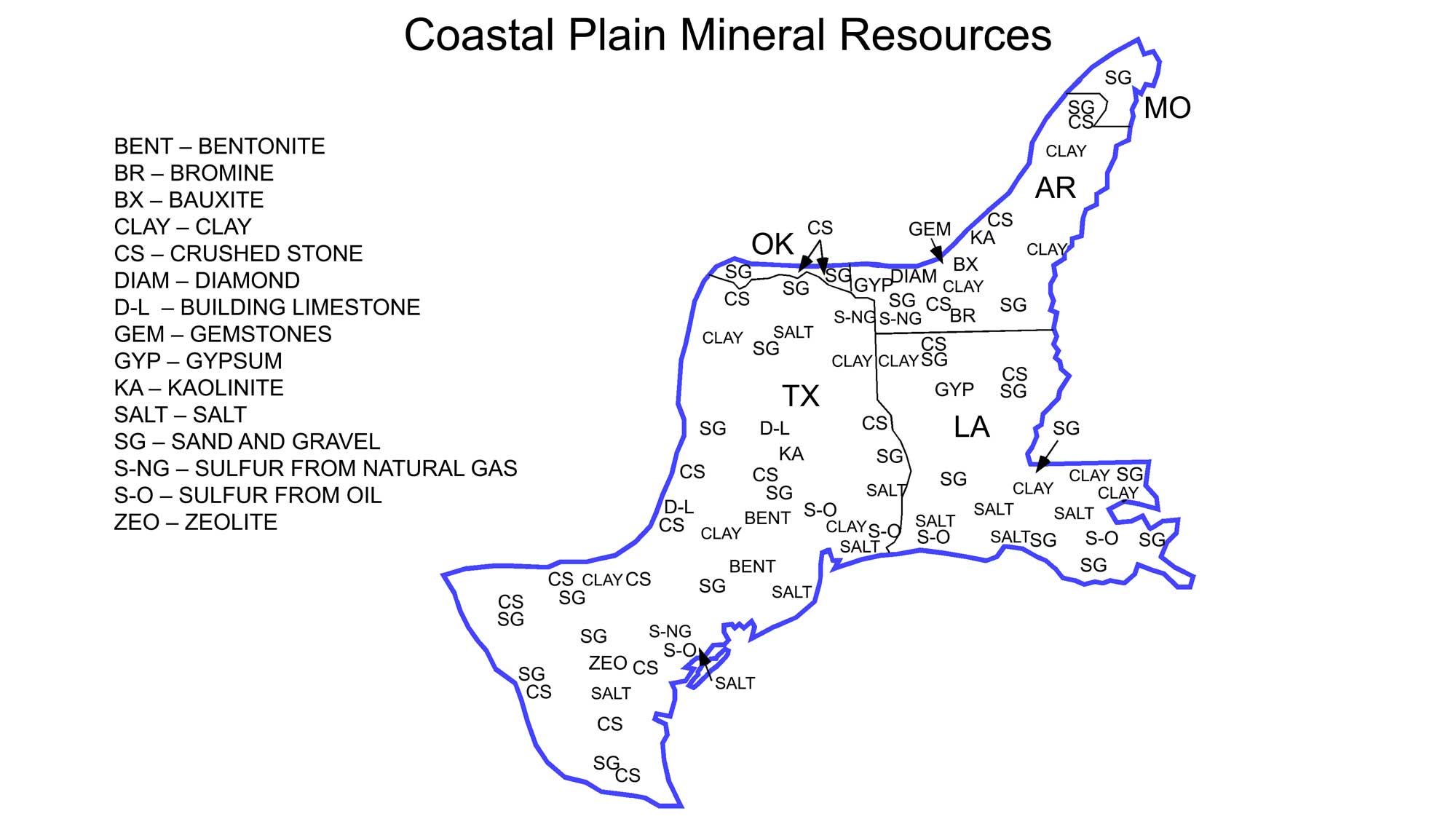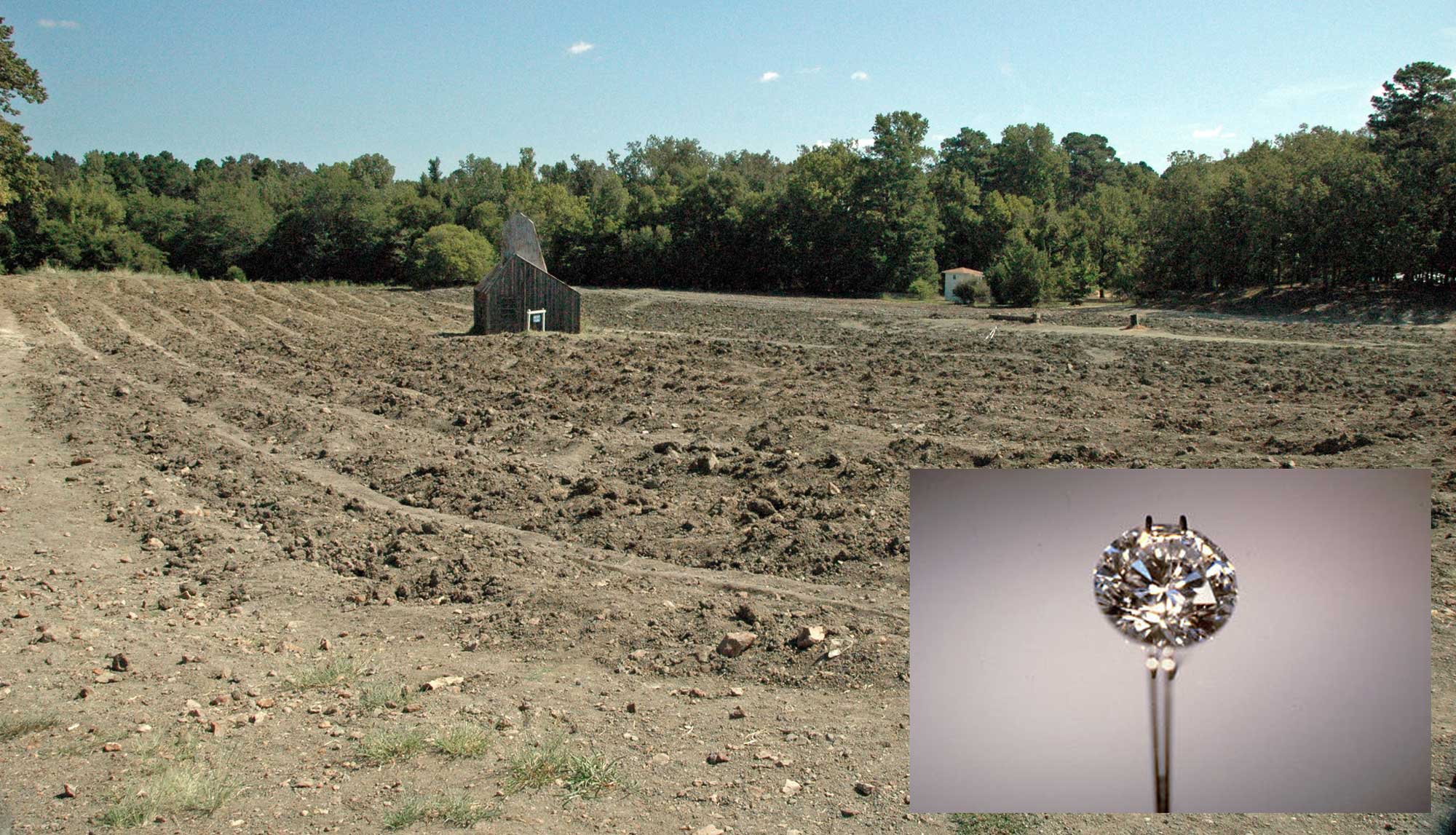Snapshot: Overview of the mineral resources of the Coastal Plain region of the South-Central United States, including all of Louisiana and portions of Missouri, Arkansas, Oklahoma, and Texas.
Topics covered on this page: Overview; Materials from Sedimentary Rock; Gemstones; Metals; Resources (references and further reading about minerals).
Credits: Most of the text of this page is derived from "Mineral resources of the South Central US" by Allen Macfarlane, chapter 5 in The Teacher-Friendly Guide to the Earth Science of the South-Central U.S., edited by Mark D. Lucas, Robert M. Ross, and Andrielle N. Swaby (published in 2015 by the Paleontological Research Institution). The book was adapted for the web by Elizabeth J. Hermsen and Jonathan R. Hendricks in 2021–2022. Changes include formatting and revisions to the text and images. Credits for individual images are given in figure captions.
Updates: Page last updated February 18, 2022.
Image above: Greeting sign at Crater of Diamonds State Park in Arkansas, where the largest diamond ever found in the United States was discovered. Photograph by "Mindy" (Flickr; Creative Commons Attribution-NonCommercial-ShareAlike 2.0 Generic license; image cropped and resized).

Overview
The Coastal Plain is underlain by thousands of feet of sedimentary rock and sediments that were deposited in both marine and terrestrial environments. Strata underlying this region consist of limestones, shales, and sandstones that were deposited in river valleys as well as in shallow seas, deltas, bays, and beaches. Cycles of deposition, erosion, and stability are tied to changes in sea level, which in turn have been influenced by Quaternary glacial and interglacial periods. Throughout the Cenozoic, the Mississippi River has continually deposited sediment in its alluvial plain, contributing to its evolving delta system. Offshore, Louisiana and Texas continue to experience the deposition of sediment from rivers emptying into the Gulf of Mexico.
Mineral resources in the Coastal Plain have accumulated primarily as a result of sedimentary processes.

Principal mineral resources of the Coastal Plain. Image adapted from the USGS 2009 State Minerals Yearbook (public domain).
Materials from sedimentary rock
Sand and gravel, limestone for cement, crushed stone, and clay are mined throughout the region. Coastal Plain clays include fire clay, ball clay, kaolin, and bentonite. Fire clay is used in the production of refractory brick, and ball clay is used to produce ceramic products. Kaolin is used in ceramics, as well as a stabilizing agent or filler in many products. Bentonite is used in drilling muds and can be used as a sealant in instances where it is important to provide a barrier for water flow through rock or sediment.
Halite, gypsum, and industrial sand are produced in Texas and Louisiana, and bromine is extracted from brine wells located in Arkansas and Texas. Sulfur is produced from sources associated with salt domes in the Texas coastal plain, and as a byproduct from the processing of oil and gas. Zeolites—porous alumino-silicate minerals with cation-exchange properties that can transform hard water into soft water—are mined in south-central Texas.
Gemstones
Although the Coastal Plain is primarily made up of sedimentary strata, small areas of Cretaceous igneous intrusions are located in southwestern Arkansas. Deposits of diamonds and other gemstones do not appear here in commercially viable quantities, but individuals may prospect for and freely remove diamonds and other gemstones they find from the Crater of Diamonds State Park in Pike County, Arkansas. These minerals are found in an ancient volcanic pipe or conduit—the volcano was so explosive that it brought minerals like diamonds, olivine, and garnet, all of which are formed at great depths, up toward the surface. When the ancient vent exploded, it left behind a crater filled with volcanic material. Today, minerals can be collected from within the weathered crater. Over 75,000 white, brown, and yellow diamonds have been found in the park, including “Uncle Sam,” the largest diamond ever found in the United States, and the Strawn-Wagner Diamond, the world’s only “perfect” diamond.

Crater of Diamonds State Park in Arkansas (photograph by James St. John; Flickr; Creative Commons Attribution 2.0 Generic license; inset image added). Inset image shows the Strawn-Wagner Diamond, which was found at this location; image by Swcom (Wikimedia Commons; Creative Commons Attribution-ShareAlike 3.0 license).
"The World's Only Public Diamond Mine - Crater of Diamonds" by Off the Cuff (YouTube).
Other gems and minerals found in the park include amethyst, banded agate, jasper, peridot, garnet, quartz, calcite, barite, and hematite.
Metals
Metals are not currently mined for commercial purposes in the Coastal Plain. While some deposits of metal-bearing minerals do occur in Texas and Arkansas, most of these deposits are either too small or low grade to be profitably mined.
Resources
Resources from the Paleontological Research Institution
Digital Atlas of Ancient Life: Minerals (collection of 3D models on Sketchfab): https://skfb.ly/6WxTo
Digital Encyclopedia of Earth Science: Minerals: https://earthathome.org/de/minerals/



